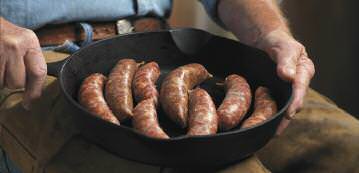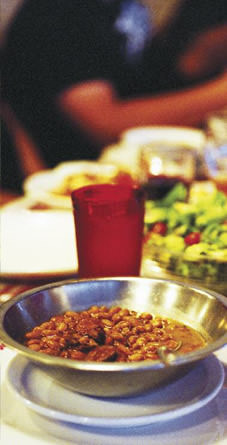cover
BASQUE IN THE GLORY
Rounding up food stories of Reno-Tahoe’s Amerikanuak.
WRITTEN BY STACEY WITTEK
PHOTOS BY STACEY WITTEK AND JEFF ROSS
T he epicure Jean Anthelme Brillat-Savarin said long ago, “Tell me what you eat and I will tell you who you are.” This is as true now as it was in 1825. We eat for sustenance, yes, and pleasure too. But we also make food choices that declare who we are and who we hope to be.
Our favorite food stories tell us where we came from and how we got here. The food story of the Amerikanuak, the Basque Americans, is one of the great origin tales. It is best served with a fruity red wine, cognac, or legendary picon punch, arms waved, and voices rich with humor and nostalgia. It is an oral history, unique to each teller, but weaves together the essence of what it is to be Basque in a strange dry land.
GOLDEN ORIGINS
The Basque came to the American West following The Gold Rush in the 1850s. Like many initially seeking the glint of gold, they quickly turned to more lucrative means of making a living. Sheepherding required no knowledge of the English language and little formal education. And an ambitious Basque émigré could own his own band of sheep and perhaps a little land in a couple of years.
The Basque immigrated for eight decades. But the great swell came between 1900 and 1920. It seemed for a while nearly all of the sheepherding companies carried Basque names. These companies, in turn, brought more men from the Basque country to work.
They were Spanish Basque or French Basque and they were from places such as Lesaka, Zuberoa, and Bizkaia. They had lived in the shadow of the Pyrenees and knew a thing or two about sheep, or not. They lived near the Bay of Biscay and ate salted cod, or not. What they shared in common was the boardinghouse.
HOME AWAY FROM HOME
If you were a young man arriving in Elko, Winnemucca, or Reno (or any of the other 17 Northern Nevadan cities that supported the ostatauk or boardinghouse), you had a final destination pinned to your coat. And you would find your first meal in the boardinghouse, conveniently located off of the railroad tracks. It is possible you were escorted to The Star in Elko or The Overland in Gardnerville by a cousin. Or maybe the sheep outfit asked the hotel owner to look out for you. Maybe you would get a little drunk listening to the accordion, your belly full of beans and fried chicken, and your head full of thoughts of the hundred sheep that would soon be under your watch.
Food was served family style and it was abundant and cheap. In many ways, the boardinghouses were like the baserriak (or farmsteads) of the old country. Life on the farm was hard and burned calories. Meals were simply flavored and fresh — seasoned with garlic, roasted peppers, and parsley. In the Basque homeland, men and women slaughtered pigs in late November, hung hams to age, and made chorizo and morcilla (or blood) sausages. But here in the American West sheep and beef ruled.
 Photo by Jeff Ross |
GOOD NIGHT, SWEET TRIPE
When the stock market crashed, so did the sheep and wool industry. The Great Depression created tension between land-owning cattlemen and tramp herders and, in response, the cattlemen lobbied for more regulation of federally owned lands. Congress complied in 1934, passing the Taylor Grazing Act, which made naturalization and citizenship necessary to grazing rights. This was difficult for the non-English-speaking herders who spent long seasons far away from cities and towns, courthouses, and schools. Many Basque people finished their company contracts and returned home.
Without herders, many boardinghouses morphed into public restaurants. A handful simply went out of business.
The character of the food changed as well. Without the steady stream of young men in the off-season, hotel owners changed the menu to appeal to a broader range of people. Out went the dinner bell ringing at the dinner hour. The tradition of family-style dining remained. But now dinner was served throughout the evening rather than at one sitting. Nontraditional choices ran alongside customary meals.
Savvy Basque owners adapted by serving ostensibly better cuts of meat and more diverse menu items to a broader clientele. Out went the tripe and in came the top round.
“You know as well as I do that people are a hell of a lot more particular nowadays than they were back then,” said Mary Aquirre in an oral history interview archived at the Center for Basque Studies at the University of Nevada, Reno. “Hell, I didn’t know what filet mignon was … when we had steak, it was round steak and, boy, when we got top round it was a real treat, you know?”
STABLE CHARACTERISTICS
One of the enduring qualities of the Basque restaurant is value. In 1937, the Nevada Hotel of Ely, Nev., charged 65 cents for dinner. Today, a choice of top sirloin or lamb chops, accompanied by soup, salad, stew, beans, French fries, a bottle of red wine, coffee, and ice cream at JT Basque Bar and Dining Room in Gardnerville, Nev., will set you back a modest $22.
And today you still will find that Basque restaurants are character driven. Typically, the restaurants are an open dining hall with rustic décor and framed photographs of ranches, local families, and letters from the homeland. They compensate for cutting-edge style with a boisterous atmosphere. Family-style dinner at The Martin Hotel in Winnemucca may find you nestled between a group of hydrologists from Desert Research Institute and mineral mine workers from Newmont Gold Company.
Once upon a time, Reno boasted a thriving community of Basque hotels — The Alturas, The Espanol, Santa Fe, and The Toscano, to name a few — all nestled within walking distance of the railroad station. Basque hoteliers whet whistles, lent money, and helped Basque men and women find work. To take in dinner at Louis’ Basque Corner or Santa Fe in Reno, or JT’s in Gardnerville is to share a piece of history.
OF MELTING POT AND ROLLS
Local Basque food success stories are rich and varied. But, at the root, they share the qualities of tenacity and adaptability. Back in the day, a cook in Golconda, Nev., created food that reflected (if not replicated) the meals of her homeland. Dishes were re-tooled to accommodate both scarcity and regional differences. And what emerged was a food phenomenon unique in time and place.
That kind of tenacity and adaptability is here today. For instance, after a rich, 40-year career as owners and stewards of Louis’ Basque Corner in Reno, Lorraine and Louis Erreguible recently sold their landmark restaurant to two young men, Brian Elcano and Chris Shanks.
“Basque food across Northern Nevada is synonymous with everything we love about this state,” Elcano says. “All of my favorite memories of Basque restaurants revolve around two events: hunting trips and family vacations. We want to follow the food tradition of old Northern Nevada boardinghouses — no frills and delicious and hearty meals that evoke a sense of community and togetherness.”
Presently, we are blessed with a panoply of fresh ingredients and imports once only a dream of many Basque immigrants. Today many local entrepreneurs and chefs are finding — in a nation that consumes $29 billion in ethnic cuisine — an opportunity to return to the Basque homeland for inspiration. Take, for example, the restaurant Orozko in John Ascuaga’s Nugget in Sparks. It serves the traditional garlic soup often found in boardinghouses. But it also serves pintxos or tapas such as Risotto Jamón Croquettes, more often seen in the world-class culinary capital San Sebastián — a city with a remarkable concentration of Michelin-starred restaurants.
This homage to tradition and adaptability to new markets is apparent in Elcano’s response to the question of what the future might hold for its endeavors.
“It’s very exciting to see Basque chefs in the major metropolitan markets bringing us upscale Basque cuisine,” Elcano says. “We think contemporary Basque cuisine would work in Reno. But that’s not the concept for Louis’. We are, however, interested in buying locally and sustainably. We use as many local vendors as possible and recently switched to domestic lamb out of Colorado.”
The Amerikanuak experience in the American West is an origin story and a creation tale. It also is far from over. What is truly lovely is that we can share in its making, too.
Stacey Wittek is a writer, photographer, and teacher, as well as a passionate researcher of history and food culture.


